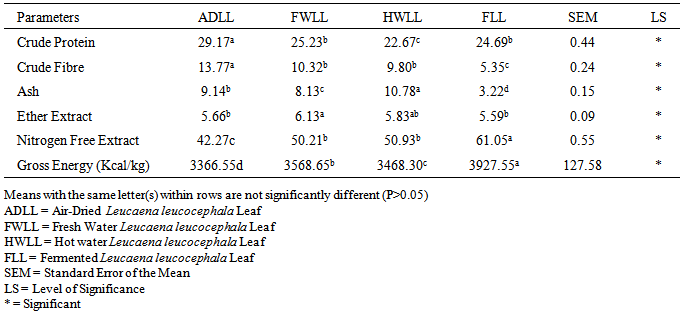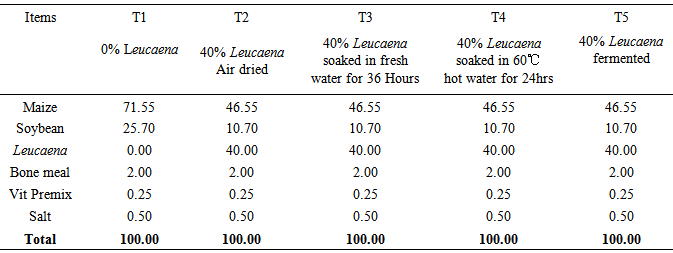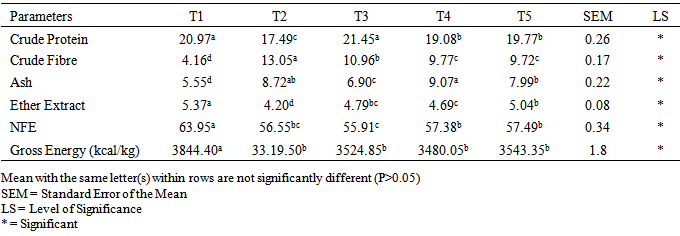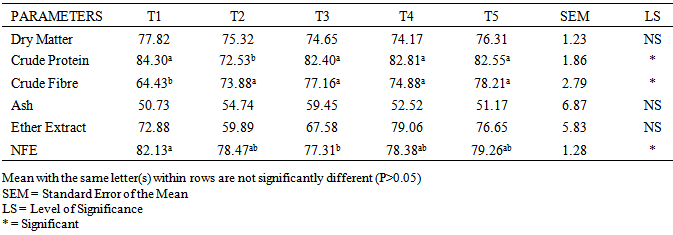-
Paper Information
- Next Paper
- Paper Submission
-
Journal Information
- About This Journal
- Editorial Board
- Current Issue
- Archive
- Author Guidelines
- Contact Us
International Journal of Agriculture and Forestry
p-ISSN: 2165-882X e-ISSN: 2165-8846
2014; 4(5): 380-385
doi:10.5923/j.ijaf.20140405.06
Effects of Different Methods of Processing Leucaena leucocephala Leaf Meal on Growth Performance and Nutrient Digestibility of Rabbits
Adekojo S. A.1, Adama T. Z.2, Aremu A.2, Ijaiya A. T.2
1Department of Agriculture, Federal College of Education Kontagora Niger State, Nigeria
2Department of Animal Production, Federal University of Technology, Minna, Niger State, Nigeria
Correspondence to: Adekojo S. A., Department of Agriculture, Federal College of Education Kontagora Niger State, Nigeria.
| Email: |  |
Copyright © 2014 Scientific & Academic Publishing. All Rights Reserved.
Processing and digestibility potentials of Leucaena leucocephala leaf meals as feed ingredient were investigated in rabbit’s diets. The leaves were collected and processed by air-drying (AD) soaked in fresh water (FW) for 36 hours, soaked in 60oC hot water (HW) for 24 hours and fermentation (FM) for 5 days. Five diets were prepared tagged (T1 – T5) T1 was the control while T2, T3, T4, and T5 contained 40% level fixed of Leucaena leucocephala AD, FW, HW and F respectively. Weaner rabbits (average weight of 510g – 640g) were subjected to 5 treatments in three replicates using a completely randomized design (CRD) for 84 days. Chemical analysis of the feed ingredients and experimental feed were conducted. The result showed that there were significant differences (P<0.05) between the treatments in the performance of the animals. The performance of the rabbits fed air-dried Leucaena leucpcephala was significantly lower (P<0.05) in all parameters except the initial weight. It is therefore recommended that all the methods of processing used in the study apart from air drying were adequate in preventing any observed harmful effect when the diet contained 40% Leucaena leucocephala.
Keywords: Processing, Leucaena leucocephala,Performance and nutrient digestibility
Cite this paper: Adekojo S. A., Adama T. Z., Aremu A., Ijaiya A. T., Effects of Different Methods of Processing Leucaena leucocephala Leaf Meal on Growth Performance and Nutrient Digestibility of Rabbits, International Journal of Agriculture and Forestry, Vol. 4 No. 5, 2014, pp. 380-385. doi: 10.5923/j.ijaf.20140405.06.
1. Introduction
- Leucaena leucocephala has been identified to hold the potential to make contributions to rabbit nutrition with the possibility of reducing a total dependence on conventional protein sources [1, 2]. Its anti-nutritional factor, mimosine has been reported to cause weight loss, ill health, organ damage and hair loss in rabbits at a level above 7.5 – 20% inclusion when fresh or unprocessed Leucaena leucocephala is included in the diet [3, 4]. This study assessed the effects of different methods of processing Leucaena leucocephala leaf meal on the performance and nutrient digestibility of rabbits (Oryctolagass cunniculus).
2. Materials and Methods
- The study was carried out at the rabbitry section of the Teaching and Research Farm of the Department of Animal Production, Federal University of technology Minna, Niger State of Nigeria. The quantity of Leucaena leucocephala leaf used for the study was sourced for within Minna. Four different processing methods were selected to reduce and alleviate the effects of mimosine on the rabbits. The first method was air-drying [5, 3], the second was soaking in fresh water at room temperature for 36 hours [6] the third was soaking in 60oC water for 24 hours while the fourth method was fermenting for five (5) days [7, 8, 3].Five experimental diets were prepared and designated as T1, T2, T3, T4 and T5. Diet T1 contained no Leucaena leucocephala leaf meal (NL) and was used as control diets. All other diets contained processed Leucaena leucocephala leaf meal at a fixed rate of 40%. Diet T2 contained air-dried Leucaena leucocephala leaf meal (AD), T3 fresh water processed Leucaena lecocephala leaf meal (FW), and T4 hot water processed Leucaena leucocephala leaf meal (HW) while T5 contained fermented Leucaena leucocephala leaf meal (FM). Experimental animals: seventy five (75) weaner rabbits of local breeds and mixed sexes were used in the study that lasted for twelve weeks after one week of adjustment to the experimental diets. The rabbits were between 5 – 6 weeks of age and weighed between 510 to 640g. The animals were randomly allotted into five treatment groups of fifteen animals per treatment. Each treatment group was replicated thrice with five rabbits in each replicate. A known quantity of the diets was served twice daily at 8.00am and 4.00pm and supplemented with 10g of Amaranthus hybidus per animal per day (dry matter). Clean water was supplied ad libitum on daily basis. The weight of each rabbit was taken after the commencement of the experiment at weekly interval. Records of feed and forage consumed were taken daily.The proximate composition of the test ingredients, and experimental diets was analyzed using [9] method. All the results were subjected to analysis of variance (ANOVA) using statistical package [10]. The variation in means were separated using the Duncan Multiple Range Test [11].
3. Results
- The effects of processing on anti-nutritional factors of Leucaena leucocephala leaf are presented in Table 2. The result showed that there were significant (P<0.05) differences on the effect of processing methods on mimosine content. The values were significantly (P<0.05) higher in air-dried (0.26 mg/100g) and lowest in 60℃ hot water treated Leucaena (0.00 mg/100g). Fresh water treated and fermented samples have (0.09 mg/100g) and (0.14 mg/100g) respectively. The effects of the processing methods on tannin, cyanogenic glycoside, phytic acid and oxalate were not significantly (P>0.05) affected but hot water treated sample had lower values.
|
|
|
|
- The results of growth performance of rabbits fed diets containing differently processed Leucaena leucocephala leaf meal are presented in Table 5. The results showed that the final body weight, average weight gain, average daily weight gain, average concentrate intake, average daily feed intake and feed conversion ratio were significantly (P<0.05) lower in rabbits fed air-dried Leucaena leucocephala leaf meal (T2) than other processing methods. The results showed that the average daily feed intake was significantly (P<0.05) higher in rabbits fed diet with no Leucaena leucocephala leaf inclusion (73.63g). This was followed by 71.73g in rabbits fed fresh water treated Leucaena leucocephala leaf, and then 71.58g in rabbit fed 60oC hot water processed Leucaena leucocephala leaf meal. The lowest feed intake was recorded in rabbits fed air-dried Leucaena leucocephala leaf meal (63.04g). The average daily weight gain was also significantly (P<0.05) lower in rabbits fed air-dried Leucaena leucocepala than other treatments. Feed conversion ratio was significantly (P<0.05) higher in rabbits fed air-dried Leucaena leucocepala (9.59), this was followed by 7.49, 7.34, and 7.32 for rabbits fed hot water treated, fresh water treated, control and fermented Leucaena leucocephala leaf respectively.
|
|
4. Discussions
- The positive effects of the processing methods observed in the reduction and /or elimination of most anti-nutritional factors are in line with the reports of (12, 13, 14, 3 15). They all reported significant (P<0.05) reduction in the contents of tannin, phytate, saponin, cyanogenic glycoside and trypsin inhibitor when feed ingredients were subjected to cooking and fermentation, [16] also reported that many anti-nutritional factors are liable to heat and that heat treatment and simple washing with water will alleviate some anti-nutritional factors. The finding of this study also corroborated the work of [17], who reported an overall 94% reduction of mimosine and 99.33% of tannin after processing Leucaena leucocephala leaf meal in both, fresh and hot water for 72 and 48 hours respectively. They however indicated that the nutritive quality of soaked leaf meal appears to be limited by other nutritional factors, such as the lack of certain amino acids. This was observed in the effects of different methods of processing on amino acid profile of Leucaena leucocephala leaf. There were significant (P<0.05) reduction in the contents of methionine and histidine with processing. Other parameters were not significantly (P>0.05) different but have lowest values in hot water processed Leucaena leucocephala leaf. This trend was in agreement with [17] who reported that simple washing removes the soluble allelochemicals but nutrients also leach out. The values of amino acids determined in this study compared with the range recommended by Organization for Economic Co-operation and Development (2011) reported by [15].The chemical composition of the experimental diet showed that they were adequate to meet the requirement of growing rabbits as recommended by [18]. The crude protein ranged from 17.49% to 21.45% and was similar to 19.95% to 22.2% reported by [3] when Leucaena based diets were fed to growing and fattening rabbits. The result obtained could be attributed to the adequacy of the processing methods in minimizing the loss of essential feed ingredients during processing [19]. The lowest quantities of mimosine and other anti-nutritional factor recorded in hot water processing method agreed with the report of [3,20] that hot water is more effective for the reduction and removal of anti-nutritional factors without appreciable loss of protein content. The lowest weight gain 6.83g/d and poorest feed conversion efficiency (9.59) observed in rabbits fed diets containing air-dried Leucaena leucocephala leaf meal could be associated to the effects of mimosine and other anti-nutritional factors that was high in air-dried Leucaena leucocephala leaf meal. This finding agrees with the report of [21] that reported a poor daily weight gain and feed intake when rabbits were fed 20% Leucaena leaf meal. They postulated that the presence of 3, 4-dihydroxyl pyridine (a product of mimosine action) in Leucaena leucocephala could act as appetite depressant. However the better results obtained for the control diet, fresh water, hot water and fermented Leucaena leucocephala leaf meal agreed with the report of [3] that reported better weight gain and feed conversion ratio for rabbits fed hot water treated and ensiled Leucaena leucocephala leaf meal. The feed conversion ratio of 7.32 to 9.59 obtained in this study was higher than 4.5-4.8 obtained by [22] when rabbits were fed different levels of wild sunflower. However the feed conversion ratio obtained in this study agreed with the findings of [23] when graded levels of gliricidia leaf meal were fed to rabbits. The prevalence of alopecia observed on rabbits fed diets containing air-dried Leucaena leucocephala leaf meal agrees with the report of [1] who observed severe loss of hair on rabbits fed 30% sun dried Leucaena leucocephala leaf meal. Similar result was reported by [21] when Leucaena was fed to rabbits, [24] reported that the inhibitory effects of mimosine on enzyme such as cystathionine synthetase involved in the conversion of cytane to methionine causes alopecia.The lower digestibility value obtained for crude protein in air dried Leucaena based diets could be due to higher mimosine content in the air dried Leucaena leucocephala leaf meal diet. This agreed with the report of [25] who observed that mimosine exerts its toxic action by blocking the metabolic pathways of aromatic amino acids and typtophan. This was also observed by [26] that mimosine can structurally acts as antagonist that inhabits protein biosynthesis in the living body and causes toxic symptoms, including growth retardation. Tannin was also reported to have dramatically reduced the utilization of protein in ruminants [27].The digestibility coefficients recorded in this study were similar to those obtained by [28, 22]. Although the diets were generally digestible the relatively low digestibility of ash observed across the treatment groups might be as a result of low percentage reduction of phytic acid content of the leaf meals. This was in line with the findings of [29] who reported that phytic acid can build to mineral elements to form complexes that are indigestible thereby decreasing the bio-availability of mineral elements in the diet of broilers.
5. Conclusions
- It could be concluded that Leucaena leucocephala leaf meal can be efficiently utilized and tolerated by weaner rabbits up to 40% inclusion level in the diet without any adverse effect on the performance when the leaf is subjected to either soaking in fresh water for 36 hours at room temperature or 60oC hot water treatment for 24 hours or fermentation for five days.
 Abstract
Abstract Reference
Reference Full-Text PDF
Full-Text PDF Full-text HTML
Full-text HTML




